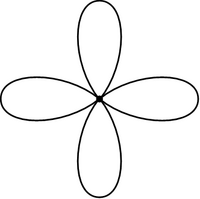Bouquet graph
In mathematics, a bouquet graph [math]\displaystyle{ B_m }[/math], for an integer parameter [math]\displaystyle{ m }[/math], is an undirected graph with one vertex and [math]\displaystyle{ m }[/math] edges, all of which are self-loops. It is the graph-theoretic analogue of the topological bouquet, a space of [math]\displaystyle{ m }[/math] circles joined at a point. When the context of graph theory is clear, it can be called more simply a bouquet.[1]

Although bouquets have a very simple structure as graphs, they are of some importance in topological graph theory because their graph embeddings can still be non-trivial. In particular, every cellularly embedded graph can be reduced to an embedded bouquet by a partial duality applied to the edges of any spanning tree of the graph,[2] or alternatively by contracting the edges of any spanning tree.
In graph-theoretic approaches to group theory, every Cayley–Serre graph (a variant of Cayley graphs with doubled edges) can be represented as the covering graph of a bouquet.[3]
References
- ↑ Topics in topological graph theory, Encyclopedia of Mathematics and its Applications, 128, Cambridge University Press, Cambridge, 2009, p. 5, doi:10.1017/CBO9781139087223, ISBN 978-0-521-80230-7
- ↑ "Twisted duality for embedded graphs", Transactions of the American Mathematical Society 364 (3): 1529–1569, 2012, doi:10.1090/S0002-9947-2011-05529-7
- ↑ Sunada, Toshikazu (2013), Topological Crystallography: With a View Towards Discrete Geometric Analysis, Surveys and Tutorials in the Applied Mathematical Sciences, 6, Springer, Tokyo, p. 69, doi:10.1007/978-4-431-54177-6, ISBN 978-4-431-54176-9, https://books.google.com/books?id=6cNEAAAAQBAJ&pg=PA69
 |


